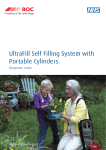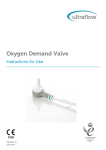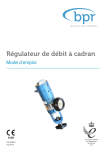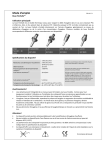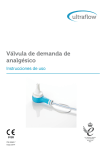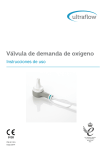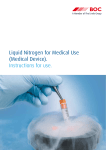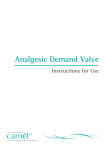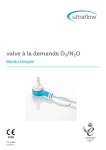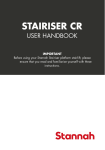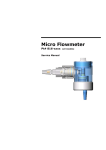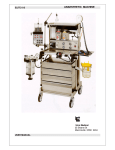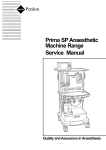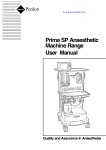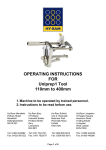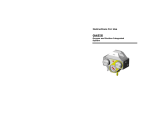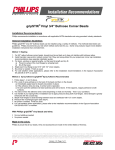Download Pressure Regulators
Transcript
Pressure Regulators Instructions for Use 702-0032.11 May 2014 1. Symbols Warning! Indicates a potentially hazardous situation which, if not avoided, could result in personal injury to the user or others Caution! Indicates a potentially hazardous situation which, if not avoided, could result in damage to the equipment or property Attention, consult accompanying documents Use no oil CE Marked to Medical Device Directive 93/42/EEC as amended by directive 2007/47/CE 0120 No smoking Service due date 1304X12345 YYMM 2. 2.1. Date of manufacture identification Warnings and Cautions Warnings! Before using the regulator read through the entire instruction manual. As with all medical equipment, attempting to use this device without a thorough understanding of its operation may result in patient or user injury. Oxygen is not flammable, however, the presence of oxygen will drastically increase the rate and severity of combustion. Oil and/or grease in the presence of oxygen become highly combustible. Oxygen must never be allowed to contact oil, grease or other petroleum-based substances. Therefore, do not use oil or grease on oxygen regulators, flowmeters, cylinders, valves or other related equipment. Never administer oxygen while smoking or when near an open flame. Oxygen therapy may be a critical treatment. A regulated flowmeter should be used in strict accordance with the prescription and instructions of a physician. The effectiveness of supplemental oxygen therapy can only be determined by continuous monitoring of blood oxygen levels. Never permit compressed medical gases to enter a regulator suddenly, always open the cylinder valve slowly. Never use medical gases from a cylinder without reducing the pressure through a suitable regulator intended for that gas. Always close the cylinder valve when the regulator is not in use. Never install a pin index regulator with more than one yoke seal between the valve and the regulator. Before attaching the regulator verify that the post valve is not already fitted with a yoke seal. Ensure that the pin-indexed connector on the regulator inlet is compatible with the gas cylinder to which it is to be fitted. Never attempt to force an incompatible connection. Ensure that you have the correct regulator for the type of cylinder you are intending to use. Never attempt to fit a regulator to an incompatible cylinder. Do not stand in front of a regulator outlet when opening the cylinder valve. Before removing a regulator from a cylinder, fully close the cylinder valve and release all gas from the regulator. Do not use or store oxygen equipment near excessive heat (>50°C or 125°F) or open flame. Only appropriately trained personnel working in controlled conditions must perform disassembly, assembly and testing of regulators and flowmeters. Only BPR Medical approved spare parts should be used to maintain the regulator. Do not submerge the device in any fluid. Ensure that no fluid is allowed to enter the inlet valve or the vent holes. The threaded bull nose cylinder connection for medical oxygen and medical air may be the same. Ensure that you have the correct cylinder for the application (UK only). The holes in the side of the body of the device are for venting gas in the event that the over pressure valve is activated. Do not obstruct these holes or interfere with the over pressure valve in any way. These regulators are designed for use for cylinder pressures up to 20,000 kPa (3,000 psi/ 200 bar), do not attempt to connect BPR Medical regulators to cylinders having fill pressures in excess of this value. 2.2. 3. Cautions The performance of the device may be affected if it is stored or transported in temperature outside of the range -20°C to +60°C. Functional Description The BPR Medical range of regulators provide a safe and convenient way of connecting high pressure gas cylinders to flowmeters, ventilators and other equipment required to run from a low pressure gas source. A regulator is connected to the gas cylinder via one of a number of different designs of inlet connector that are the result of differing gas bottle connection standards across the world. The lower outlet pressure of the regulator is achieved by balancing the force applied by the gas on a piston head with a spring of known characteristics. A valve seat limits the flow of gas, restricting the force that can be applied on the piston head until such time as a state of equilibrium can be reached in the system (i.e. the outlet pressure). The specific characteristics of the valve seat, piston and spring combine to determine the outlet pressure. As gas is drawn from the regulator, the outlet pressure drops and the valve opens in an attempt to maintain the equilibrium under the new gas flow conditions. An over pressure valve (OPV) protects the user from any high gas pressures by venting excess pressure to ambient. The OPV is a spring loaded valve with a pre-set operating pressure. Particulate filtering in the form of a 40 micron inlet filter is incorporated to prevent the ingress of debris, which may alter the performance of the device and increase the risk of a fire. Outlet pressure is available at the outlet connector to enable the end user to fit the intended delivery device (e.g. flowmeter). 4. Operating Instructions Check that the cylinder type and regulator inlet connector are compatible. Check the presence and condition of the input connector seal. Note: For pin index regulators this is a washer type seal (yoke seal) and an O-ring for bull nose regulators. Check that a suitable device (e.g. flowmeter) is correctly connected to the output of the regulator. Fit the regulator to the cylinder ensuring that it is properly mated and the connectors are done up hand tight. Open the cylinder valve with a suitable cylinder key. Check the regulator cylinder contents gauge to verify that there is sufficient gas available. Continue to check the regulator contents gauge. Upon completion of the therapy, close the cylinder valve and disconnect any outlet hoses that might be connected to the patient. To remove the regulator from the cylinder, first ensure the cylinder valve is closed. Bleed off any residual gas pressure in the regulator by turning on the connected ancillary device. Remove the regulator from the cylinder and store it carefully where it will be protected from contamination. 5. 5.1. Maintenance User Maintenance and Inspection All regulators should be inspected and tested on an annual basis to ensure correct performance. Wipe down the outside of the device with an alcohol wipe. Do not allow the ingress of water or other solution into the device. Check the exterior condition of the device. Notes: 5.2. • Pay particular attention to the input connector seal and cylinder contents gauge. • Check that the holes in the side of the body of the device for venting gas in the event of relief valve activation are not obstructed or have otherwise been tampered with. Service/Repair Regulators must be serviced on or before the Service Due date stated on the regulator rating label. The lack of servicing or incorrect servicing are the main causes of incidents with medical gas regulators and it is strongly advised that devices are serviced according to the instructions given in the Service Manual. Servicing may be undertaken by suitably qualified engineers working in appropriate conditions who have undergone formal training with BPR Medical. 6. Specification Oxygen/Air Pressure Regulator Specification Rated Pressure (P1) 900 kPa – 20,000 kPa Rated Outlet Pressure (P2) 400 kPa Standard Discharge (Q1) 40 l/min Operating, Storage and Transport Temperature Range -20 °C to +60 °C Standard Warranty 1 year Service Interval 4 years O2/N2O Pressure Regulator 2,000 kPa – 20,000 kPa Applied Standards BS EN ISO 10524-1 Pressure regulators for use with medical gases. Pressure regulators and pressure regulators with flow-metering devices BS EN ISO 14971 Medical devices. Application of risk management to medical devices BS EN ISO 15223-1 Medical Devices. Symbols to be used with medical device labelling and information to be supplied. General requirements. BS EN 1041 Information supplied by the manufacturer of medical devices 6.1. Typical Flow Performance Regulator Performance 500.00 Output Pressure (kPa) 450.00 400.00 Input Pressure (kPa) 350.00 300.00 16000 15000 250.00 200.00 10000 150.00 5000 100.00 2000 50.00 0.00 10 20 30 40 50 60 70 80 Flowrate in l/min 90 100 110 120 130 140 7. Parts and Spares List Part Number Inlet Connection Outlet Connection Gas Type 819-0009 Pin Index 3/8” BSP Oxygen 819-0010 Pin Index BS 5682 Oxygen 819-0011 Pin Index 1/4” Hose Oxygen 819-0012 Pin Index 1/8” BSP Female Oxygen 819-0015 Bullnose 3/8” BSP Oxygen 819-0016 Bullnose BS 5682 Oxygen 819-0017 Bullnose ¼” Hose Oxygen 819-0034 Pin Index Schrader Air 819-0035 Pin Index 1/4” Hose Air 819-0039 Pin Index 3/8” BSP Air 819-0040 Bullnose Schrader Air 819-0063 Pin Index Schrader Oxygen 819-0076 Bullnose BS 5682 (left) Oxygen 819-0079 Bullnose Schrader (left fixed block) Oxygen 819-0083 Pin Index BS 5682 Air (high flow) Spare Parts and Servicing 212-0012 Bull Nose Seal 212-0094 Pin Index Yoke Seal 303-0030 Boot for Cylinder Gauge 303-0060 Swivel Cylinder Contents Gauge 0.3mm Restriction 610-0039 Regulator Service Kit (Pack 10) 610-0057 Bodok Bonded Seal (Pack 50) 610-0058 Bull Nose O-ring Seal (Pack 50) 8. Distributor Details BOC Healthcare Customer Service Centre Priestly Road Worsley Manchester M28 2UT T: +44 (0)8456 447 764 F: +44 (0)8450 870 062 www.bochealthcare.co.uk BPR Medical Limited T: +44 (0)1623 628 281 22 Hamilton Way, Mansfield F: +44 (0)1623 628 289 Nottinghamshire [email protected] NG18 5BU, United Kingdom www.bprmedical.com









